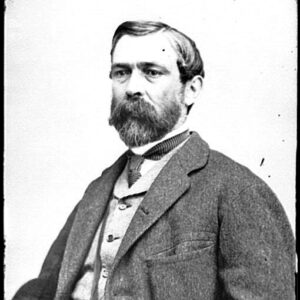calsfoundation@cals.org
Thirty-Eighth Arkansas Infantry (CS)
The Thirty-Eighth Arkansas Infantry was a Confederate unit that served in the Trans-Mississippi Theater during the American Civil War. The unit was composed of men primarily from Craighead, Independence, Izard, Lawrence, and Randolph counties. The regiment began organization in June 1862 as a mounted infantry unit but was dismounted in August 1862 and mustered into Confederate service with ten companies on September 21, 1862, at Jacksonport (Jackson County). The elected field officers of the unit were Colonel Robert G. Shaver, Lieutenant Colonel William. C. Adams, and Major Milton Baber.
The Thirty-Eighth Arkansas experienced its first combat on December 7, 1862, at the Battle of Prairie Grove. Assigned to a brigade commanded by Shaver of Frost’s Division, the Thirty-Eighth, under Adams, supported Colonel Joseph Shelby’s cavalry on the far right wing of the Confederate lines. During the battle, the Thirty-Eighth’s casualties consisted of five killed, twenty-five wounded, and twenty-two missing. That evening, due to lack of supplies, Brigadier General Thomas Hindman retreated back to Van Buren (Crawford County), and the Thirty-Eighth returned to central Arkansas, establishing winter quarters near Little Rock (Pulaski County).
By the spring of 1863, the regiment had been reassigned to the brigade of Brigadier General James Tappan and then ordered to Louisiana that summer, supporting General Richard Taylor’s forces opposing General Ulysses S. Grant’s operations near Vicksburg, Mississippi. Confederates operated near Lake Providence, Louisiana, to disrupt agricultural efforts on the U.S.–leased plantations. The Thirty-Eighth operated in the vicinity of Delhi, Louisiana, aggressively attacking and burning plantations and disrupting Union efforts. This culminated in the Battle at Goodrich’s Landing on June 29, 1863, where they assisted in destroying property, securing much-needed supplies, and capturing a portion of the First Arkansas Infantry (African Descent).
Missing the Battle of Helena on July 4, 1863, Tappan’s Brigade returned to Arkansas in August 1863 to assist in the defense of Little Rock. During the initial cavalry battles of August 1863, Confederate infantry, including the Thirty-Eighth, held strong works east of the city and north of the Arkansas River. When Union cavalry successfully forded the Arkansas River below Little Rock on September 10, 1863, the infantry withdrew through Little Rock, retreating to Arkadelphia (Clark County), thus giving up the state capital to the enemy. Soon afterward, the Twenty-Seventh and Thirty-Eighth Arkansas were consolidated under the command of Shaver, with Tappan’s Brigade assigned to Churchill’s Arkansas Division.
In the spring of 1864, Union forces in Louisiana moved northward in the Red River Campaign, hoping to link up with General Frederick Steele’s Army of Arkansas in the vicinity of Shreveport and capture the Confederate headquarters of the Trans-Mississippi Department. In defensive maneuver, all infantry, including Churchill’s troops, were ordered south in time to participate in the Battle of Pleasant Hill, turning back the Union advance. General E. Kirby Smith marched north with his infantry to assist Major General Sterling Price, who held Steele’s army at bay near Camden (Ouachita County). After defeats at Poison Spring and Marks’ Mills and running out of supplies, Steele hastily retreated toward Little Rock.
On April 30, Confederate infantry caught Steele’s troops trying to cross the flooded Saline River at Jenkins’ Ferry. Churchill’s Arkansas Division, the first to arrive, immediately deployed for action. Tappan’s Brigade led the first assault in the dismal bottoms, with the Twenty-Seventh/Thirty-Eighth on the right and Hardy’s Nineteenth/Twenty-Fourth Arkansas on the left. As they advanced, heavy fighting erupted all along the line. While their comrades were pinned down in a cornfield, Shaver led his men forward into the swampy woods where they succeeded in pushing back the enemy. As Hardy’s men began to retreat, Shaver, flanked on his left and right, was forced to withdraw as well. As the other Arkansas brigades, and then the Missouri Division, failed in frontal assaults on Union positions, Shaver was ordered to the far left along the main road and Cox Creek, in support of the Texas Division. The Thirty-Eighth supported the Texans’ advance during this final assault, withdrawing under orders, as that attack also failed. The enemy, during this lull, took the opportunity to retreat across the river, leaving the Confederates in control of the battlefield. During the battle, the Twenty-Seventh/Thirty-Eighth Arkansas lost four men killed and twenty-two wounded in what became its last combat action.
Serving the remainder of the war in Arkansas and Louisiana, the regiment was stationed at Marshall, Texas, when General Kirby Smith surrendered the department on May 26, 1865. Ordered to Shreveport to receive their paroles, the regiment did not report but simply disbanded without formally surrendering. Most individually journeyed to their homes, receiving their paroles at various locations along the way.
For additional information:
Bearss, Edwin C. Steele’s Retreat from Camden and the Battle of Jenkin’s Ferry. Little Rock: Pioneer Press, 1995.
Shea, William. Fields of Blood: The Prairie Grove Campaign. Chapel Hill: University of North Carolina Press, 2009.
Turnbo, S. C., and Desmond Walls Allen. History of the Twenty-Seventh Arkansas Confederate Infantry. Conway, AR: Arkansas Research, 1993.
———. Turnbo’s Tales of the Ozarks: War and Guerrilla Stories. Conway, AR: Arkansas Research, 1989.
Anthony Rushing
Bryant Public Schools
 Civil War through Reconstruction, 1861 through 1874
Civil War through Reconstruction, 1861 through 1874 Military
Military Richard Taylor
Richard Taylor 




Comments
No comments on this entry yet.